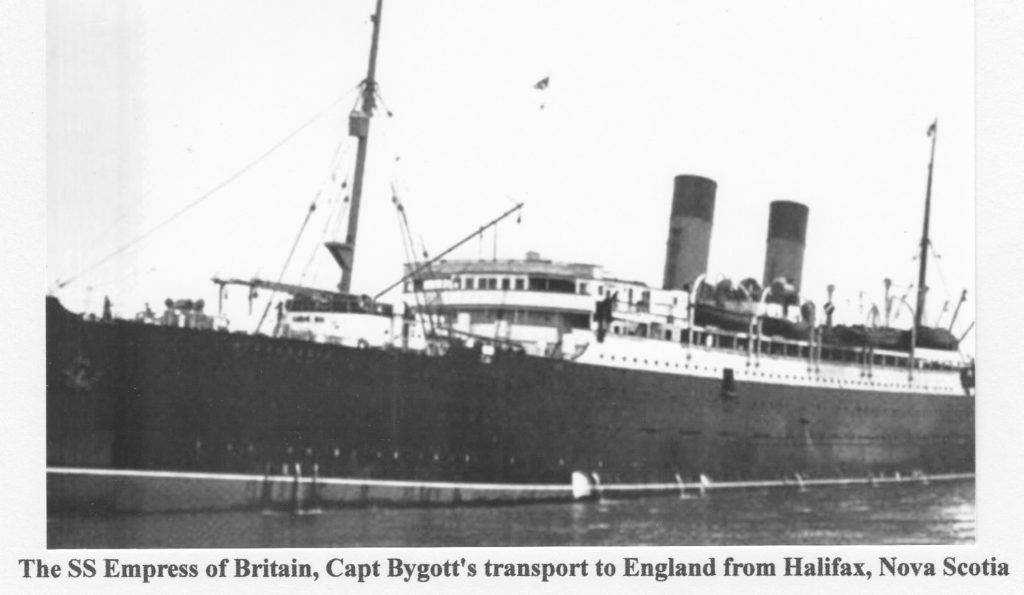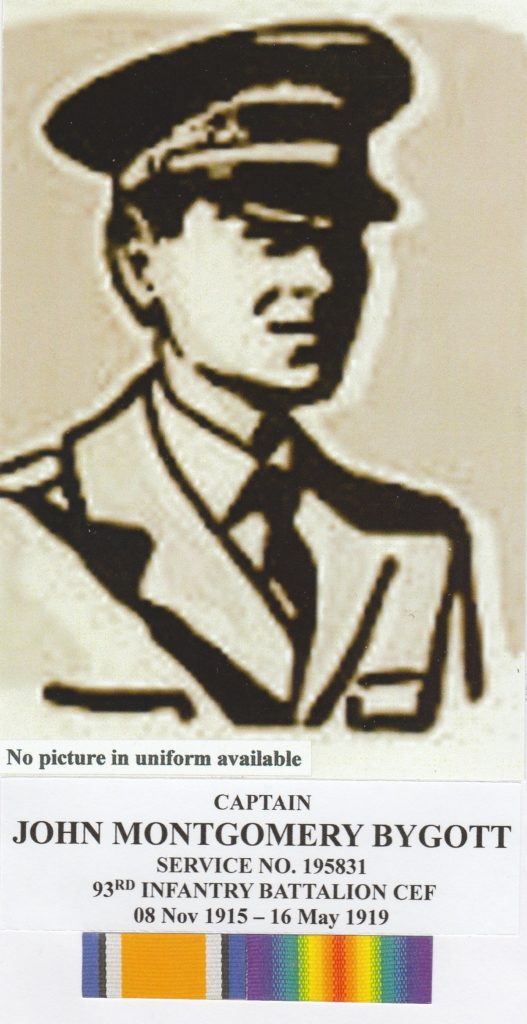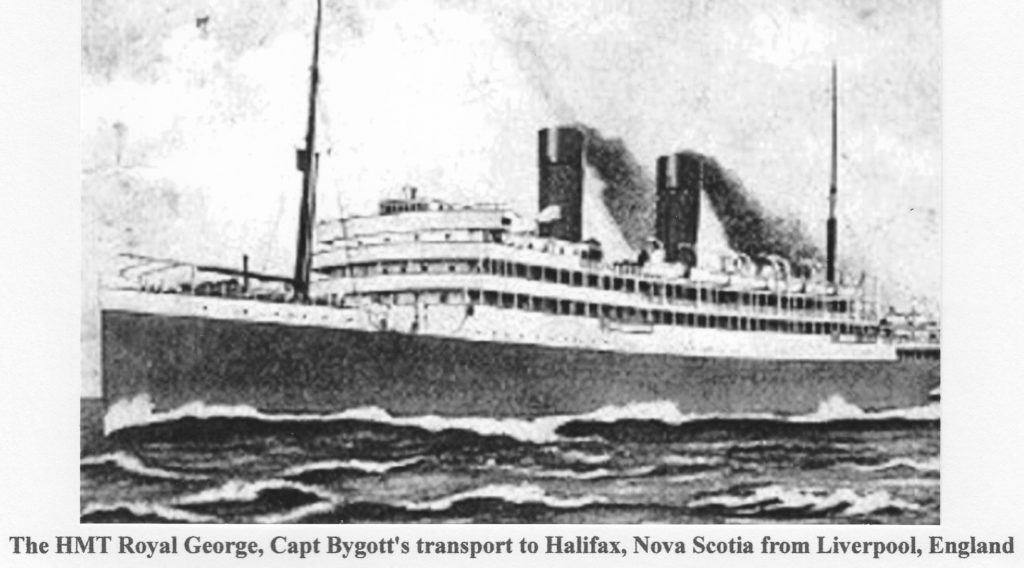MILITARY HISTORY
Captain John Montgomery Bygott – ACTIVE SERVICE (World War I)
According to the Certificate of Service John Montgomery Bygott enlisted with the 93rd Battalion, Canadian Expeditionary Force (CEF) and was ”Appointed to the Commissioned Rank” of Captain (Capt) with the 93rd Battalion (Bn) on November 6, 1915. John Montgomery completed the Officer’s Declaration Paper where he indicated that he was born in Stirling, Ontario on July 9, 1875. John Montgomery was 40 years and 4 months old when he enlisted. He indicated that his present address was Lakefield, Ontario and his next-of-kin is listed as his wife Annie Bygott, also of Lakefield. John Montgomery indicated that he had four children: one boy and three girls. As far as his profession or occupation he lists Livery Keeper. On the Officer’s Declaration Paper he indicated that he belonged to the 46th Regiment and that he had served with the 46th Regiment for 3 years. The Certificate of Medical Examination was completed in Peterborough, Ontario on December 9, 1915 and he was deemed Fit for the CEF Overseas. He was 5′ 10½” tall and weighed 155 pounds.
The 93rd Bn was authorized and formed up December 22, 1915. After training through the winter and spring at 5 different area Centres, Apsley being one, the Bn departed by train from Peterborough on May 29, 1916. The 93rd Bn made a short stop at Camp Barriefield located at Kingston, Ontario before moving on the main CEF Training Centre located at Valcartier, Québec so as to complete Basic Infantry training before being transported overseas, to the United Kingdom (UK).
Capt Bygott and the 93rd Bn embarked from Halifax, Nova Scotia aboard the SS Empress of Britain on July 15, 1916.

Capt Bygott and the 93rd Bn disembarked in England on July 25, 1916. They were stationed at Shorncliffe, England. The 93rd Bn provided reinforcements to the 1st Canadian Corps in the Field.
On August 19, 1916 Capt Bygott qualified 2nd in a Class of 26 Officers Course at the Canadian School of Musketry. September 19, 1916 he was posted to the permanent cadre with the 93rd Canadian Infantry Battalion (CI Bn). October 6, 1916 Capt Bygott was transferred to the 39th CI Bn CEF at West Sandling, England. On October 7, 1916 he was taken-on-strength with the 39th CI Bn. On November 29, 1916 Capt Bygott was admitted to the Military Hospital at Shorncliffe with a pain in the left leg. He was diagnosed with Periostitis on the outer side of the Tibia brought about by physical exercise. Capt Bygott was declared unfit for General Service for one month. The Medical Board found him fit for Home Service on December 13, 1916. Capt Bygott was discharged on December 16, 1916. On January 4, 1917 he ceased to be attached to the 39th CI Bn at West Sandling. On the same day he was attached to the 6th Canadian Reserve Battalion (Cdn Res Bn), General List. On January 13, 1917 he was declared, by the Medical Board, to be fit for General Service. January 31, 1917 he ceased to be attached to the General List and was taken-on-strength with the 6th Cdn Res Bn at East Sandling, in Kent.
The 6th Cdn Res Bn (Eastern Ontario) stationed at West Sandling was formed January 4th, 1917 under the Command of Lt Col M.A. Colquhoun by absorbing the 39th Canadian Reserve Battalion (Cdn Res Bn) and one half of the 168th Cdn Res Bn. The 154th Cdn Res Bn was absorbed January 31, 1917. It moved to Seaford, in Sussex on March 2, 1917. The 252nd and 254th Cdn Res Bns were absorbed June 10, 1917. The purpose of the Cdn Res Bns were to supply reinforcements to Canadian Infantry Battalions in France. For that purpose the 6th Cdn Res Bn sent reinforcements to the 2nd, 21st, 38th CI Bns and the Princess Patricia’s Canadian Light Infantry (PPCLI) Bn. On August 13, 1917 Capt Bygott proceeded to London en-route to Canada and he was shown as ”On Command”.
There is no indication that Capt Bygott actually went to Canada. In fact, the next entry of September 4, 1917 indicating that he was struck-off-strength from the 6th Cdn Res Bn on being posted to the Eastern Ontario Regimental Depot (EORD) at Seaford in Sussex County, England. On the same day that he was taken-on-strength with the EORD, he was shown as attached for duty at the War Office. This would indicate that he never left England.
The EORD was a facility used to assemble men and stores and administer equipment and materials need in the Field.
September 10, 1917 he was shown as Seconded to the War Office for duty. There is no indication in his File as to where Capt Bygott was from September 10, 1917 to March 1918 and then about April 1918 to December 16, 1918.
On December 16, 1918 Capt Bygott was admitted to the No 8 Canadian Stationary Hospital in Dunkirk, France. He was discharged on December 22, 1918. On December 31, 1918 his File indicates that Capt John Bygott had been mentioned in Dispatches by Sir Douglas Haig.
There is no indication as to why he was mentioned in Dispatches. Research into Sir Douglas Haig’s Dispatches failed to shed any specific reference to Capt Bygott. However; what is interesting is through further research, a reference to Capt John Montgomery Bygott of the 93rd Canadian Battalion was made by a Capt Russell, Officer Commanding of the No 4 Australian Broad Gauge Railway Operating Company dated March 31, 1918 recommending Capt Bygott for the Military Cross. This recommendation was based on Capt Bygott’s actions during the German Offensive in March 1918. The recommendation reads: ”For conspicuous bravery and devotion to duty, whilst supervising and directing the removal of wounded and rolling stock from Roisell and Tincourt on March 21st, by his coolness under shell fire he inspired all concerned to greater effort and materially aided the success which attained these operations”. There is no indication in his File that he received the Military Cross.
On February 18, 1919 Capt Bygott ceased to be Seconded for duty with the War Office. On the same day he was granted Leave from February 18, 1919 to March 5, 1919. Upon his return from Leave on March 5, 1919 he was struck-off-strength from the Eastern Ontario Regimental Depot on posting to the 6th Cdn Res Bn at Seaford, England. On March 28, 1919 Capt Bygott was taken-on-strength from the 6th Canadian Reserve Battalion and placed ”On Command” to the Military Depot 3 Wing at Kinmel Park. May 3, 1919 he was struck-off-strength to Canada. On the same day he embarked from Liverpool aboard the HMT Royal George.
Capt Bygott disembarked in Halifax, Nova Scotia May 14, 1919. May 16, 1919 he was struck-off-strength from the Canadian Expeditionary Force in Canada on General Demobilization.
There is no reference, in Captain John Montgomery Bygott’s Military File indicating what Military Medals he was awarded but based on his Military Service, he should have received:
British War Medal 1914 – 1920; and
Victory Medal.
He also qualified for War Service Badge CEF Class “A”.
Based on his Military File, Capt John Montgomery Bygott served a total of 3 years, 6 days, and 10 days with the Canadian Expeditionary Force: 8 months and 11 days in Canada; about 1 years, 6 months in England; about 1 year 3months in France and 20 days travel time.
An excerpt from an article in Maclean’s Magazine by Barbara Ameil, September 1996:
”The Military is the single calling in the world with job specifications that include a commitment to die for your country. What could be more honourable”?
PERSONAL HISTORY
JOHN MONTGOMERY BYGOTT
John Montgomery Bygott born June 9, 1875 in Rawdon Township, Hastings County, son of James Wilson Bygott and Mary Montgomery. He grew up on the family farm. On January 16, 1889, John married Annie Florence McNabb in the County of York (Toronto, Ontario). Annie Florence was born November 18, 1874, daughter of James McNabb and Ellen Allardice.
According to the 1901 Census John and his wife Annie were lodgers at the home of Mary Baptie in Lakefield, Ontario. John was listed as working as a railway agent.
By 1911, John and his wife were residing in Lakefield on East Queen Street with their three children: Helen Montgomery born January 27, 1894; Kathleen Florence born July 27, 1906 and Isabelle Allardyse born March 1910. At this time John was working as a livery man at a livery barn. John and Annie would have two more children: John Francis “Jack” born in 1912 and Roderick Creighton who died from capillary bronchitis on September 19, 1914, age 7 months & 14 days and is buried in Hillside Cemetery.
Annie Florence Bygott died in 1944 and John Montgomery Bygott died in 1962; both are buried in the Christ Church Anglican Cemetery in Campbellford, Ontario.
THE JOHN MONTGOMERY BYGOTT OF LAKEFIELD
John Montgomery Bygott’s paternal grandparents are John and Elizabeth Bygott. John Bygott was born in 1812 and died December 19, 1881 and his wife Elizabeth was born in 1812 and died December 18, 1889; both are buried in the Stirling Cemetery, Stirling Ontario.
John Montgomery Bygott’s parents are; James Wilson Bygott and Mary Montgomery, farmers living in Rawdon Township in Hastings County. They had a family of four children: Annie born in 1869; John Montgomery born in 1875; Francis George born in 1877 and James Wilson Jr. stillborn in 1879.
In later years, James Wilson (Sr) worked in the Port Hope area as a Railway Foreman. In 1881, parents John and Elizabeth were living with James Wilson and Mary and their family in Rawdon Township, Hastings County. James Wilson Bygott was born April 4, 1836 and died July 10, 1903; Mary Montgomery was born November 29, 1942 and died November 15, 1907; both are buried in the Stirling Cemetery.
In 1891 John and Mary were living in the County of North Hastings, Rawdon Township with them were their two children: son John M. 16; son Frank 13 and niece Mary I. born in Ireland.

